Ilankai Tamil Sangam30th Year on the Web Association of Tamils of Sri Lanka in the USA |
||||||
 Home Home Archives Archives |
Prabhakaran’s Tigers and Mandela’s SpearsPart 7by Sachi Sri Kantha, March 23, 2012
Camparison Chart of Mandela & Prabhakaran
The bombastic Sri Lankan Army If there is an Olympic medal for bombast and vanity, men from Sri Lankan army would win it hands down, every four years. During LTTE-Indian army confrontation period (October 1987 to March 1990), Sri Lanka had two army chiefs. They were Nalin Seneviratne (1931-2009) and Hamilton Wanasinghe (b. 1933). I checked the Wikipedia entry for Sri Lanka’s ex-army chief Nalin Seneviratne [accessed on March 21, 2012]. About his achievements in the Sri Lankan army, the biodata states,
With their penchant for puffing up the deeds in battlefields, numerous ‘medals’ were concocted for significant (or more properly, insignificant) battles, by the Sri Lankan military. Quite a number of ‘medals’ carried the tags of place names of the North-East regions of the island. Vadamarachchi Operation Medal was one of these. The medals and badges in the official photos of Sri Lanka’s army commanders remind me of a Cheney cartoon of a general’s vanity parade that appeared in the New Yorker (Aug.17, 1987). I couldn’t locate a specific entry for Hamilton Wanasinghe biography in the wikipedia [accessed on March 21, 2012], probably because he is black-listed by the current political hierarchy, as he supported the current President’s opponent General Sarath Fonseka in the 2010 presidential election. A cynic would quip that the best medal that should adorn the uniform of Seneviratne and Wanasinghe would be a wimp medal during 1987-1990 for not engaging the Indian army, which landed in Sri Lanka after the Rajiv Gandhi- Jayewardene Accord.
An Army full of Wimps Now, let me provide some evidence on what the Sri Lankan army did, when LTTE was tackling the Indian army during 1987-1990. In June-July 1989, there arose an occasion that the then commander-in chief President R. Premadasa was locking horns with the then Indian prime minister Rajiv Gandhi about requesting immediate withdrawal of the Indian army from the island. Naively, he even believed that the Sri Lankan army generals (if
The details presented in these two news items identify the Sri Lankan army wimps lucidly. Prabhakaran and his associate military leaders, in leading LTTE, against the officially stated “45,000 Indian troops” were never daunted by the might of his adversary. They carried on their struggle valiantly, and eventually turned tables against their adversaries. I guess that the anonymous ‘Colombo correspondent’ for the Economist magazine could have been Mervyn de Silva. Among all the Sinhalese journalists, he was an exception in evaluating the strength of Prabhakaran’s leadership on its terms, without racist bias. Isn’t it humorous that the Sri Lankan military generals who prided themselves with Vadamarachchi Operation Medal in 1987, had a serious bout of ‘thigh-shaking’ fever in 1989, when their Commander in Chief called them for offensive action against the Indian army? Comparison between Mandela and Prabhakaran: My own table In part 6, I provided my own table comparing MK and LTTE. Here, I provide my table with 18 criteria comparing the lives of Nelson Mandela and Velupillai Prabhakaran. The details in it are accurate, to the best of my ability. The sources from which I made this table are provided at the end of this part. Though an age difference of 36 years exists, please note the similarities between Mandela and Prabhakaran in personal habits and personality. Betrayers of MK and LTTE Betrayers had been a bane to secret networks in history. One could begin with Judas Iscariot, the 12th apostle who betrayed Jesus Christ. Incidentally, the March 2012 issue of National Geographic’s cover feature was on the Christian Apostles. Even Uncle Sam’s secret network CIA routinely suffer from betrayal, (the latest being that of Aldrich Ames) in their mission. I have identified two betrayers for MK and three betrayers for LTTE (see Table). Of the two betrayers for MK, Mandela makes mention of Bruno Mtolo, in his autobiography. I reproduce the 6 paragraphs on this episode, relating to his Rivonia treason trial. Percy Yutar (1911-2002), mentioned was the prosecuting deputy attorney general for South African apartheid regime.
Mandela’s biographer Martin Meredith, includes Patrick Mthembu (a founding MK member), in addition to Bruno Mtolo. He was killed by MK operatives in 1978 for his betrayal, according to his son Diliza Mthembu. Martin Meredith’s descriptions about these two betrayers are reproduced below:
As for LTTE, Mahattaya betrayal was covered by Adele Balasingham in her The Will to Freedom (2001) book. Colonel Karuna’s betrayal had been covered by me in my Pirabhakaran Phenomenon (2005) book, and in many opinion pieces in this website. Kumaran Pathmanathan’s betrayal waits for more expose.
In 1977, after listening to the readings of works by political prisoners, American humorist Art Buchwald jabbed in his inimitable style: “In this country, when you attack the Establishment, they don’t put you in jail or a mental institution. They do something worse. They make you a member of the Establishment.” [Time, Dec.5, 1977, p. 20] At that time, Mandela was in jail. The Cincinnati Post’s editorial cartoonist Stahler’s 1990 cartoon when Mandela visited the USA depicts the same sentiment partially. What Buchwald was probably commenting relates to Martin Luther King Jr., who was made a distinguished member of the Establishment and decorated with the Nobel Peace Prize in 1964. The same fate did repeat to Nelson Mandela too, when he too was decorated with the Nobel Peace Prize in 1993, at the age of 75 years. For various reasons, Prabhakaran missed out on this Establishment prize. Compared to Mandela, Prabhakaran probably was too young. The near thing, Prabhakaran received as a sort of International recognition, was being anointed as one of the 100 Most Influential Asians of the Century by the Time magazine. [August 23-30, 1999]. Of course, Prabhakaran did not make to the top 20 primary selections (19 men and one woman). But, Prabhkaran was included in the next rung of 80 secondary selections, in the category of insurgents, “who fought their own governments for causes ranging from communism to freedom”. Prabhakaran was only 45 then. The primary selection for this category was Vietnam’s independence leader Ho Chi Minh (1890-1969). Even among the five secondary selections in which Prabhakaran was included, two were composites (Japanese soldiers who revolted in 1936, and the Afghanistan’s mujahedin guerrillas who defeated the Soviet army). Sources Consulted Adele Balasingham: The Will to Freedom. Fairmax Publishing, Mitcham, UK, 2001. Martin Meredith: Nelson Mandela – a biography. Penguin Books, London, 1997. Nelson Mandela: Long Walk to Freedom –the autobiography of Nelson Mandela. Little Brown and Co, Boston, 1994. Sachi Sri Kantha: Pirabhakaran Phenomenon, Lively Comet Imprint, Japan, 2005. V. Visvanatha Pillai: A Dictionary – Tamil and English, 6th edition, 1951, Madras, p.514 (for the meaning of Prabhakaran name). *****
|
|||||
|
||||||

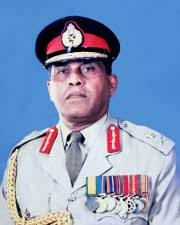
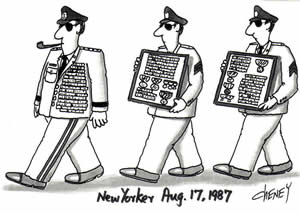 called for combat) would affirmatively answer his call. But, this didn’t happen in reality, because Sri Lankan army was full of wimps. I provide scans from two international newsmagazines nearby, and offer excerpts [indicated in red boxes]:
called for combat) would affirmatively answer his call. But, this didn’t happen in reality, because Sri Lankan army was full of wimps. I provide scans from two international newsmagazines nearby, and offer excerpts [indicated in red boxes]: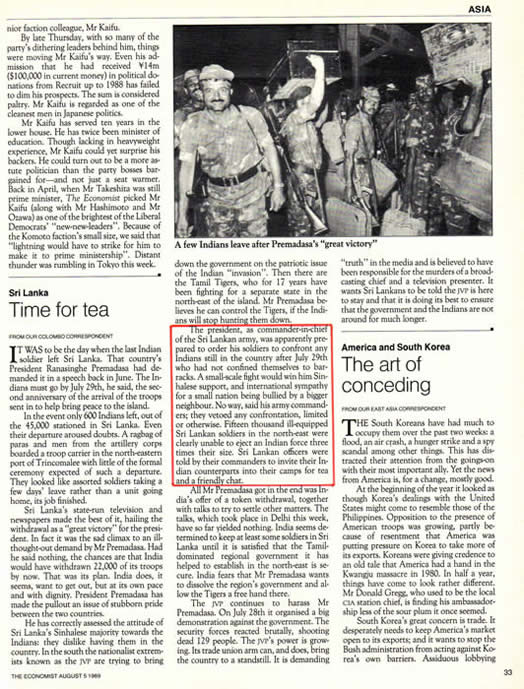
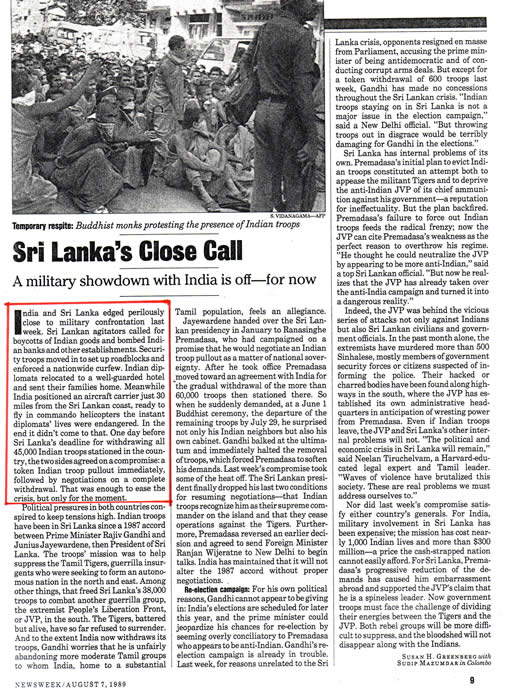
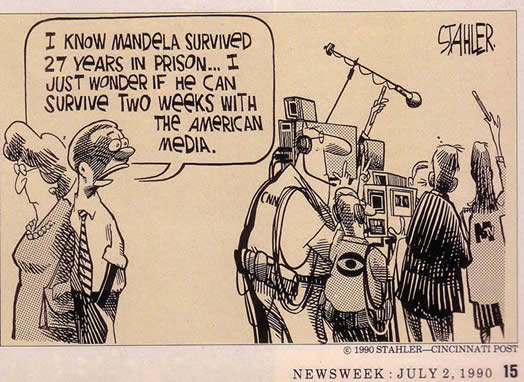 International Recognition by the Establishment
International Recognition by the Establishment